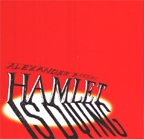These Sounds are Actors, Too By Alexander Bakshi The music collected here will not satisfy those seeking the pure sound of a studio recording or even a typical live concert. These are the essentially undoctored recordings of first-time performances, complete with the inescapable noises that retain the atmosphere of the performance sites. In one case, this means a large church in Lockenhaus; in another it is a run-down rehearsal hall near Taganka Square in Moscow. I am addressing listeners who, as I do, love the THEATRE OF SOUND. I do not appeal to those who are fond of CONCERTS, that last bastion of the dead epoch of Great Composers. The Concert has always been the monologue of a Genius towering over the crowd. It is a platform from which those who have been inspired by God project their lyrical revelations and prophecies. Bound by the contours of the stage, the music of the Concert has become an object of worship. This bastion, however, is crumbling. Music is returning to its source, to the sacred space of ritual and theatre, a space bound up in myth. Shakespeare, Shostakovich and Sidur -- in fact, all of the greats in world art -- became myths of a new age. A living myth, however, requires the collaboration of one who is capable of retelling and commenting on the myth. That is what I do when composing theatre. My desire is to unite the arts of music and theatre without the intermediary of literature. I do not want sound to be illustrating the word. I do not want chanting singers straining to imitate the artlessness of human speech. I am seeking the true nature of things! Theatre is always visual. However, foremost for me is the sonic mise en scene, the division of the theatrical space into discrete zones and the polyphony of rhythms. I do not work in the conventional environment of the concert hall where sound is projected in a single direction, outward from the stage. I work with a specific, three-dimensional acoustic environment where the listener exists within the music. Unfortunately, this quality cannot be captured in a recording. The theatre is a collaborative art. I have never written for the violin or the piano. There are no two violinists, pianists or singers alike -- each differs in vocal tone, in stride, in his or her habit of rustling sheet music and in his or her manner of coughing. In other words, I write for specific people. That is why Gidon Kremer, Tatyana Grindenko, Peter Sadlo and KREMERata BALTICA, Lyudmila Bakshi and Mark Pekarsky and the musicians of his percussion ensemble are not merely the performers of my music, they are the co-authors. The compositions collected here are the product of our mutual love for the creative act. 'Hamlet is Dying' - is a little performance, the subject of which is only indirectly connected with Shakespeare. At the very beginning of the concert behind of the stage the members of the orchestra are pronouncing: 'treason, treason…' in English and in Russian. In the play this text is pronounced by the court circle after Hamlet's fatal injury. But a listener would accept these words as a certain general rumble - in the way that the dying hero would hear them... The deathbed visions and recollections of Hamlet (whose 'part' is played by the Gidon Kremer's violin) - that is the dramatic progression of the composition. That is why the whole musical material has been growing up from the intonations and mode, which is exposed in the opening monologue of the soloist. So, the 'action' begins from the moment, when in Shakespeare's play it's practically over. I did not try to translate immortal tragedy into the language of music. The composition is based not on the literature, but on the myth about Shakespearean Hamlet. There is no literary story in 'Sidur Mystery'. Only the sound of Vadim Sidur's text at the beginning of the performance - the poem 'Io, Leda, Danae…' which ends with the words: I will create Eve for myself In climbing the Tree. These words contain the progression of the plot: the musicians appearing in the deserted cellar - the studio of the genius sculptor - are creating the sculptures from sounds. The musical dramatic composition is built on the conflict of the Sidur's main images: sensuality - suffering - death - creation. Besides the usual musical instruments there are sounds of sheets of iron pipes, hammers, nails, springs and other rubbish of civilization. These are all materials often used by the sculptor in his work. A special construction from the metallic sheets, strings and brass pipes was constructed by Vadim Morozoff for the performance. It's possible to imitate strings and percussion and even voices with the help of this construction. The mystery is completed with the sound of this construction. The performance lasts about an hour and a half. The version presented here is condensed. The 'Shostakovich Concerto' for violin and strings was composed in the year of anniversary of the Soviet classic. The challenge of this little composition was to create the 'image' of music of this composer's music - which is the essence of his dramatic collisions and conflicts.
Shipping method
After the confirmation of the order we send the disks by Russian Post with tracking option.
Shipping time
The standard shipping by air from Russia to any country usually takes not more than 3 weeks (15 business days).
Shipping costs
1-10 disks - $20
11-15 disks - $25
16-20 disks - $30
more than 20 - double quantity USD
Payment
The preferred payment type is PayPal.
We prefer to send the disks after the payment.
In some cases it is possible that we send the disks before the payment.
Refund
Issuing refunds is possible if there are some problems.


